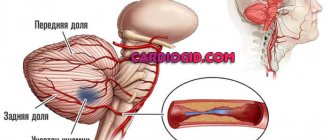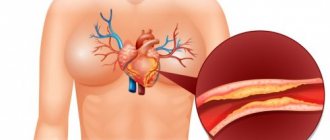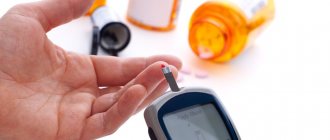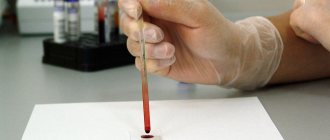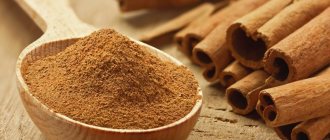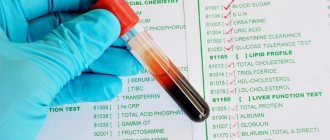Atherosclerosis
Diabetes
Arthritis
Gout
9899 14 October
IMPORTANT!
The information in this section cannot be used for self-diagnosis and self-treatment.
In case of pain or other exacerbation of the disease, diagnostic tests should be prescribed only by the attending physician. To make a diagnosis and properly prescribe treatment, you should contact your doctor. We remind you that independent interpretation of the results is unacceptable; the information below is for reference only.
Cholesterol: indications for use, rules for preparing for the test, interpretation of results and normal indicators.
What does cholesterol look like?
Many people think of cholesterol as fat and believe that the fattier the food, the more cholesterol it contains. This point of view is only partly justified. Cholesterol is found in the blood and looks like a viscous substance. Cholesterol cannot be considered exclusively harmful, because it is consumed by the body in the process of producing hormones and forming cell membranes. To varying degrees, cholesterol is involved in the functioning of the immune, nervous and digestive systems, so a certain amount of cholesterol must be contained in the body at all times. Another thing is that keeping it within acceptable limits is not always easy.
Excess cholesterol
tends to deposit on the inner walls of arteries.
At first, this is an imperceptible process, but gradually, due to the cholesterol layer, the diameter of the artery narrows, and blood begins to pass through it worse. In places where the vessel narrows, a dense formation is formed from the cholesterol layer, which is commonly called a “ cholesterol plaque
.”
Cholesterol plaques not only almost completely block the flow of blood through the vessel, but also reduce its elasticity. The process of cholesterol formation is called “ atherosclerosis
”.
By themselves, single cholesterol plaques do not pose a serious health hazard, but if you do not take action, over time there will be too many of them. In addition, cholesterol plaque
- This is the initial stage of
thrombus
. Often blood clots form where atherosclerotic plaques were located. The danger of a blood clot is that it completely seals the vessels and can block the flow of blood to vital organs. If a blood clot occurs in a vessel supplying the heart, a person may have a myocardial infarction, and if blood flow stops in a vessel supplying the brain, the person may suffer a stroke.
Does high cholesterol cause death?
Cholesterol itself is not considered deadly. Complications caused by high cholesterol levels can lead to death. We have already named some of them. Atherosclerosis can trigger the development of coronary heart disease, and one of the complications can be myocardial infarction, stroke, acute thrombosis and other diseases. The list can be large and is determined by which arteries were affected.
Fish and omega-3 fatty acids
Fish and omega 3 fatty acids
Eating fatty fish is good for your heart because it contains high amounts of omega-3 fatty acids, which reduce blood pressure and the risk of blood clots. In people who have had heart attacks, fish oil and omega-3 fatty acids reduce the risk of sudden death.
Cardiologists recommend eating at least 2 servings of fish per week. The largest amounts of omega-3 fatty acids contain:
- mackerel;
- river trout;
- herring;
- sardines;
- longfin tuna;
- salmon;
- halibut.
To avoid adding unhealthy fats, fish should be baked or grilled. If you don't like fish, you can get some omega-3 fatty acids from foods like flaxseed meal, camelina oil, or canola oil.
Another option is to take omega-3 fatty acid or fish oil supplements, but then you won't get other nutrients that fish also contain (such as selenium). If you plan to use such supplements, please consult your physician first.
Is all cholesterol the same?
Cholesterol is found in the blood, but does not dissolve in it. Cholesterol is carried throughout the body by lipoproteins. High density lipoprotein (HDL) molecules
move cholesterol from the arteries to the liver. Later, this cholesterol is excreted from the body and is not deposited on the walls of blood vessels. Such cholesterol is considered “good” because it not only does not increase, but reduces the risk of developing cardiovascular diseases.
Another type of cholesterol carried by low-density lipoprotein (LDL) molecules
from the liver throughout the body. In peripheral tissues, cholesterol gradually settles on the walls of blood vessels, resulting in the formation of atherosclerotic plaques. It is important for a person to monitor and prevent an increase in the level of low-density lipoproteins, or “bad” cholesterol.
Another form of lipids that provide the body with energy, but in large quantities can be harmful, are triglycerides. They are synthesized by the liver or enter the body with food, and then pass into the blood. A high content of triglycerides in the blood is also undesirable, since it can disrupt the functioning of the circulatory system.
Cholesterol is necessary for the human body, but excess of it is definitely harmful. Deviation from the norm in the direction of lowering cholesterol concentration is also dangerous.
Cholesterol is a fat-like substance that is vital for humans. It is part of the membranes (membranes) of all cells in the body, there is a lot of cholesterol in nervous tissue, and many hormones are formed from cholesterol. About 80% of cholesterol is produced by the body itself, the remaining 20% comes from food. Atherosclerosis occurs when there is a lot of low-density cholesterol in the blood. It damages the lining of the inner wall of the vessel, accumulates in it, resulting in the formation of atherosclerotic plaques, which then turn into mush, calcify and clog the vessel. High levels of cholesterol in the blood mean an increased risk of heart disease. Our organs contain approximately 200 grams of it, and there is especially a lot of it in the nervous tissue and brain.
For a long time, cholesterol was considered literally the personification of evil. Foods containing cholesterol were outlawed, and cholesterol-free diets were extremely popular. The main accusation was based on the fact that atherosclerotic plaques on the inner surface of blood vessels contain cholesterol. These plaques cause atherosclerosis, that is, a violation of the elasticity and patency of blood vessels, and this, in turn, is the cause of heart attacks, strokes, brain diseases and many other ailments. In fact, it turned out that to prevent atherosclerosis, it is important not only to monitor cholesterol levels, but also to pay attention to many factors. Infectious diseases, physical activity, the state of the nervous system, and finally, heredity - all this affects the blood vessels and can provoke atherosclerosis or, conversely, protect against it.
And with cholesterol itself, everything turned out to be not so simple. Scientists have found that there are both “bad” and “good” cholesterol. And to prevent atherosclerosis, it is not enough to reduce the level of “bad” cholesterol. It is important to maintain the “good” level at the proper level, without which the normal functioning of internal organs is impossible.
Every day, the average person's body synthesizes from 1 to 5 g of cholesterol. The largest proportion of cholesterol (80%) is synthesized in the liver, some is produced by body cells, and 300-500 mg comes from food. Where do we spend all this? About 20% of the total amount of cholesterol in the body is found in the brain and spinal cord, where this substance is a structural component of the myelin sheath of nerves. In the liver, bile acids are synthesized from cholesterol, which are necessary for the emulsification and absorption of fats in the small intestine. 60-80% of the cholesterol produced daily in the body is spent on these purposes. A small part (2-4%) goes to the formation of steroid hormones (sex hormones, adrenal hormones, etc.). Some cholesterol is used to synthesize vitamin D in the skin under the influence of ultraviolet rays and to retain moisture in body cells. Thanks to laboratory studies conducted by a group of researchers in Germany and Denmark, it was found that a component of blood plasma that can not only bind, but also neutralize dangerous bacterial toxins is low-density lipoproteins - carriers of the so-called “bad” cholesterol. It turns out that “bad” cholesterol helps support the human immune system. Therefore, you just need to make sure that the level of “bad” cholesterol does not exceed the known norm, and everything will be fine.
In men, strict adherence to cholesterol-free products can negatively affect sexual activity, and in women who are too active in the fight against cholesterol, amenorrhea often occurs. Dutch doctors claim that low levels of this substance in the blood are to blame for the spread of mental illness among Europeans. Experts advise: if you have depression, you need to do a blood test for cholesterol - perhaps it is its deficiency that deprives you of the joy of life.
Other studies have shown that the most favorable ratio of “bad” and “good” cholesterol in the blood is observed in people whose diet contains 40-50 percent fat. For those who practically do not consume fat, the blood content of not only “harmful” cholesterol, which is involved in the formation of atherosclerotic plaques, is reduced, but also its beneficial forms, which protect blood vessels from atherosclerosis.
It is very important that “good” and “bad” cholesterol are balanced in relation to each other. Their ratio is determined as follows: the total cholesterol content is divided by the “good” cholesterol content. The resulting number must be less than six. If there is too little cholesterol in the blood, then this is also bad.
Normal levels of cholesterol in the blood According to the official recommendations of the European Society of Atherosclerosis (a very respected organization in the West), “normal” levels of fatty fractions in the blood should be as follows: 1. Total cholesterol - less than 5.2 mmol/l. 2. Low-density lipoprotein cholesterol - less than 3-3.5 mmol/l. 3. High-density lipoprotein cholesterol - more than 1.0 mmol/l. 4. Triglycerides - less than 2.0 mmol/l.
How to eat right to lower cholesterol It is not enough to simply give up foods that cause the production of “bad” cholesterol. It is important to regularly consume foods containing monounsaturated fats, omega-polyunsaturated fatty acids, fiber, and pectin to maintain normal levels of “good” cholesterol and help remove excess “bad” cholesterol.
Healthy cholesterol is found in fatty fish, such as tuna or mackerel. Therefore, eat 100 g of sea fish 2 times a week. This will help keep the blood in a thin state and prevent the formation of blood clots, the risk of which is very high with high levels of cholesterol in the blood.
Nuts are a very fatty food, but the fats contained in various nuts are mostly monounsaturated, that is, very beneficial for the body. It is recommended to eat 30 g of nuts 5 times a week, and for medicinal purposes you can use not only hazelnuts and walnuts, but also almonds, pine nuts, Brazil nuts, cashews, and pistachios. Sunflower, sesame and flax seeds perfectly increase the level of healthy cholesterol. You eat 30 g of nuts by eating, for example, 7 walnuts or 22 almonds, 18 cashews or 47 pistachios, 8 Brazil nuts.
Among vegetable oils, give preference to olive, soybean, flaxseed oil, and sesame seed oil. But under no circumstances fry in oils, but add them to prepared food. It is also healthy to simply eat olives and any soy products (but make sure that the packaging states that the product does not contain genetically modified components).
To remove “bad” cholesterol, be sure to eat 25-35 g of fiber per day. Fiber is found in bran, whole grains, seeds, legumes, vegetables, fruits and greens. Drink bran on an empty stomach, 2-3 teaspoons, be sure to wash it down with a glass of water.
Don't forget about apples and other fruits that contain pectin, which helps remove excess cholesterol from the blood vessels. There are a lot of pectins in citrus fruits, sunflowers, beets, and watermelon rinds. This valuable substance improves metabolism, removes toxins and heavy metal salts, which is especially important in unfavorable environmental conditions.
To remove excess cholesterol from the body, juice therapy is indispensable. Among fruit juices, orange, pineapple and grapefruit (especially with the addition of lemon juice), as well as apple, are especially useful. Any berry juices are also very good. Among vegetable juices, traditional medicine recommends potent juices of beets and carrots, but if your liver is not working perfectly, start with a teaspoon of juice.
Green tea is very useful for high cholesterol; it kills two birds with one stone - it helps increase the level of “good” cholesterol in the blood and reduces the level of “bad” cholesterol. Also, in consultation with your doctor, it is good to use mineral water in treatment.
An interesting discovery was made by British scientists: 30% of people have a gene that increases the amount of “good” cholesterol. To wake up this gene, you just need to eat every 4-5 hours at the same time.
It is believed that consuming butter, eggs, and lard significantly increases blood cholesterol levels, and it is better to avoid consuming them altogether. But recent studies prove that the synthesis of cholesterol in the liver is inversely related to its amount coming from food. That is, synthesis increases when there is little cholesterol in food, and decreases when there is a lot of it. Thus, if you stop eating foods containing cholesterol, it will simply begin to form in large quantities in the body.
To maintain cholesterol levels within normal limits, first of all, avoid saturated and especially refractory fats contained in beef and lamb fat, and also limit the consumption of butter, cheese, cream, sour cream and whole milk. Remember that “bad” cholesterol is only found in animal fats, so if your goal is to lower your blood cholesterol levels, then reduce your intake of animal foods. Always remove the fatty skin from chicken and other poultry, which contains almost all the cholesterol.
When you cook meat or chicken broth, after cooking, cool it and skim off the congealed fat, since it is this refractory type of fat that causes the greatest harm to blood vessels and increases the level of “bad” cholesterol.
The likelihood of developing atherosclerosis is minimal if you: • are cheerful, at peace with yourself and with the people around you; • do not smoke; • don't drink alcohol; • love long walks in the fresh air; • are not overweight and have normal blood pressure; • do not have hormonal abnormalities.
How to lower cholesterol with folk remedies Linden to lower cholesterol A good recipe for high cholesterol: take dried linden flower powder. Grind linden flowers into flour in a coffee grinder. Take 1 tsp 3 times a day. such fake flour. Drink for a month, then break for 2 weeks and take linden for another month, washing it down with plain water. At the same time, follow a diet. Eat dill and apples every day, because dill contains a lot of vitamin C, and apples contain pectin. All this is beneficial for blood vessels. And it is very important to normalize cholesterol levels by improving the functioning of the liver and gallbladder. To do this, take infusions of choleretic herbs for two weeks, taking a break for a week. These are corn silk, immortelle, tansy, milk thistle. Change the composition of the infusion every 2 weeks. After 2-3 months of using these folk remedies, cholesterol returns to normal, and a general improvement in well-being is observed.
Propolis for removing “bad” cholesterol To cleanse blood vessels of cholesterol, you need to take 7 drops of 4% propolis tincture dissolved in 30 ml of water 3 times a day, 30 minutes before meals. The course of treatment is 4 months.
Beans will lower cholesterol Cholesterol levels can be reduced without problems! In the evening, pour half a glass of beans or peas with water and leave overnight. In the morning, drain the water, replace it with fresh water, add a teaspoon of baking soda to the tip (to prevent gas formation in the intestines), cook until tender and eat this amount in two doses. The cholesterol-lowering course should last three weeks. If you eat at least 100 g of beans per day, your cholesterol level decreases by 10% during this time.
Alfalfa will remove “bad” cholesterol. One hundred percent remedy for high cholesterol is the leaves of alfalfa. You need to treat with fresh herbs. Grow at home and, as soon as the sprouts appear, cut them and eat them. You can squeeze the juice and drink 2 tbsp. 3 times a day. The course of treatment is a month. Alfalfa is very rich in minerals and vitamins. It can also help with diseases such as arthritis, brittle nails and hair, and osteoporosis. When your cholesterol levels are normal in all respects, follow a diet and eat only healthy foods.
Flaxseed to lower cholesterol You can lower the level of bad cholesterol with flaxseed, which is sold in pharmacies. Add it to the food you eat regularly. You can first grind it in a coffee grinder. The pressure will not jump, the heart will become calmer, and at the same time the functioning of the gastrointestinal tract will improve. All this will happen gradually. Of course, the diet should be healthy.
Healing powder for lowering cholesterol Buy linden flowers at the pharmacy. Grind them in a coffee grinder. Every day, take 1 teaspoon of powder 3 times. Course 1 month. By doing this you will lower cholesterol in the blood, remove toxins from the body and at the same time lose weight. Some people lost 4 kg. Your health and appearance will improve.
Dandelion roots for atherosclerosis to remove excess cholesterol in the blood from the body Dry powder of crushed dry roots is used for atherosclerosis to remove excess cholesterol from the body and remove harmful substances. 1 tsp is enough. powder before each meal, and after 6 months there is an improvement. There are no contraindications.
Eggplants, juices and rowan berries will lower cholesterol. Eat eggplants as often as possible, add them raw to salads, after holding them in salt water to remove the bitterness. In the morning, drink tomato and carrot juices (alternate). Eat 5 fresh red rowan berries 3-4 times a day. The course is 4 days, the break is 10 days, then the course is repeated 2 more times. It is better to carry out this procedure at the beginning of winter, when frosts have already “hit” the berries.
Celery will lower cholesterol and cleanse blood vessels. Chop the celery stalks in any quantity and put them in boiling water for a couple of minutes. Then take them out, sprinkle with sesame seeds, lightly salt and sprinkle with a little sugar, add sunflower or olive oil to taste. It turns out to be a very tasty and satisfying dish, absolutely light. They can have dinner, breakfast and just eat at any time. One condition - as often as possible. True, if you have low blood pressure, then celery is contraindicated.
Licorice will remove bad cholesterol 2 tbsp. crushed licorice roots, pour 0.5 liters of boiling water, simmer over low heat for 10 minutes, strain. Take 1/3 tbsp. decoction 4 times a day after meals for 2 - 3 weeks. Then take a break for a month and repeat the treatment. During this time, cholesterol will return to normal!
Prevention of high cholesterol To prevent the deposition of cholesterol on the walls of blood vessels, you need to adjust your diet. There is a lot of cholesterol in red meat and butter, as well as in shrimp, lobsters and other shelled animals. Ocean fish and shellfish have the least cholesterol. They also contain substances that help remove cholesterol from cells, including cells of internal organs. Eating large amounts of fish and vegetables reduces cholesterol levels in the blood and prevents obesity and cardiovascular diseases - the main cause of death in the civilized population.
In order to control cholesterol levels, you need to do a special blood test every six months. The normal level of “bad” cholesterol ranges from 4-5.2 mmol/l. If the level is higher, then you need to see a doctor.
What increases cholesterol?
Increased cholesterol levels can be due to various factors. The first thing you should pay attention to is your diet
.
If a person has a slight increase in cholesterol levels, doctors usually recommend that they eat less foods high in saturated fat, but certain health problems can also contribute to high cholesterol levels. For example, chronic renal failure or decreased thyroid function. Some people may have high cholesterol levels “naturally” and be inherited. This genetic abnormality is called “ familial hypercholesterolemia
”.
When shaping your diet, you need to remember that cholesterol is found only in products of animal origin. This argument is often made in favor of a plant-based diet by vegetarians. However, this does not mean that if animal food is excluded, the rest of the diet can be uncontrolled. Food fried in vegetable oil and products containing palm oil can also have a negative effect on lipid metabolism.
Olive oil
The benefits of olive oil
Another good source of MUFA is olive oil.
To benefit your heart, try to consume 2 tablespoons (23 g) of olive oil daily, replacing other fats. You can sauté vegetables in olive oil, add it to marinades, or mix it with vinegar for salad dressings. When frying meat, use olive oil instead of butter.
Both avocados and olive oil are high-calorie foods, so don't eat more than the recommended amount.
Do healthy people need to monitor their cholesterol?
Often people begin to monitor certain indicators when problems appear and their health worsens, but prevention is always better than cure. The concept of “healthy person” is too general. You may not have liver or metabolic problems now, but that doesn't mean you won't have them in the future. People with identified lipid metabolism disorders should regularly undergo cholesterol tests, but others should not check the strength of their body.
If your diet often contains fatty foods, high-calorie foods, and in general you like to indulge in sweets, then sooner or later this will increase your cholesterol. Other cardiovascular risk factors may also have an impact. As a result, you risk getting atherosclerosis with all the attendant consequences.
Cholesterol norm
If, according to the test results, your cholesterol is normal, then there is no serious cause for concern. Provided you follow the rules of a healthy diet and a healthy lifestyle, the next examination can be done in a few years.
If the cholesterol level is elevated ( from 5 to 6.4 mmol/l or more
), then it’s worth monitoring it every six months to observe the dynamics. At the same time, you need to reconsider your diet, remove foods that increase cholesterol, and also give up bad habits: smoking and drinking alcohol. Your doctor should warn you about additional risks associated with the presence of concomitant diseases.
over 6.4 mmol/l is considered a high-risk level.
. This indicator indicates the need for specialized treatment, since there is a high probability of developing coronary heart disease and other cardiovascular complications. The treatment program should be drawn up by a doctor based on the tests performed, including identifying the level of LDL, HDL and triglycerides.
Other dietary changes
For these products to really be beneficial, you will have to reconsider your diet and adjust your lifestyle.
Although the benefits of some types of fats were discussed above, the consumption of others - saturated fats and trans fats - should be limited. Saturated fats, found in meats, butter, cheese and other full-fat dairy products, as well as some vegetable oils, raise total cholesterol levels. Trans fats, often used in margarines or store-bought cookies, crackers or cakes, are especially unhealthy. They increase LDL and decrease HDL - the so-called. “good” cholesterol. If a product label says “partially hydrogenated oils,” the product contains trans fats and is best avoided.
In addition to changing your diet, you should also adjust your overall lifestyle - this is the key to improving your cholesterol levels. Exercise, quitting smoking and maintaining a healthy weight will help you normalize your cholesterol levels.
Make an appointment Do not self-medicate. Contact our specialists who will correctly diagnose and prescribe treatment.
Risk group for atherosclerosis
Atherosclerosis
- an insidious disease that develops gradually. Cholesterol level is an indirect indicator of the risk of developing atherosclerosis, but some categories of people need to be tested for cholesterol at certain intervals. The following recommendations are given:
- men over 40 years old;
- women over 45 years old;
- people with diagnosed diabetes;
- overweight people;
- people with diseases of the thyroid gland, kidneys and high blood pressure;
- smokers;
- people who lead a sedentary lifestyle.
It is important to understand that at the first stage of development, atherosclerosis has no visible specific manifestations. A person may not even be aware of the developing disease and the problem with cholesterol. Therefore, doctors recommend regularly donating blood for biochemical analysis.
Causes of High Cholesterol
Causes of high cholesterol can be:
- overweight;
- eating large amounts of sweet and fatty foods;
- smoking;
- alcohol consumption;
- sedentary lifestyle;
- pregnancy.
High cholesterol is characteristic of certain diseases:
- congenital hyperlipidemia;
- pathologies of the hepatobiliary system;
- pancreas cancer;
- diabetes;
- hypothyroidism;
- kidney pathologies.
When should you start monitoring your cholesterol?
It's never too early for prevention. It’s better to get used to monitoring your health from a young age, then it will present you with fewer unpleasant surprises. It is especially important to pay attention to your health after 40 years of age
, this is true for both men and women. In men, coronary heart disease may begin to develop earlier than in women. This is explained by hormonal levels. Women of childbearing age have more “good” cholesterol in their bodies, while in men the preponderance may lean toward “bad” cholesterol. After menopause, women's bad cholesterol levels may also begin to rise along with their triglyceride levels.
If previously it was believed that atherosclerosis mainly affects mature and elderly people, now the disease is diagnosed in younger patients, so it would be reasonable to start controlling cholesterol levels at 30-35 years of age. If the analysis shows that everything is normal, a re-check can be carried out after 3-4 years, but if the cholesterol level is elevated or there is a genetic predisposition to the development of heart and vascular diseases, then it is worth checking the cholesterol level more often.
Do children suffer from high cholesterol?
Cholesterol levels in children, as a rule, do not rise above normal, but they can also be at risk if hereditary hypercholesterolemia is found in their family. In this case, the child will be registered with a pediatric cardiologist from an early age. A cholesterol test should be done at the age of two years, and then repeated periodically.
Read more about acceptable levels of the compound in the blood
When talking about average cholesterol standards, it is impossible to classify all people into one category. The fact is that indicators change throughout life and depend on age, gender, lifestyle, concomitant diseases, taking certain medications and other factors.
For example, doctors have found that women under 50 suffer less frequently from manifestations of vascular atherosclerosis, and, accordingly, increased amounts of bad cholesterol. This is due to the maintenance of capillaries in good condition by the production of estrogen, the female sex hormone. After 50 years, when menopause begins, blood cholesterol levels in men and women approximately equalize.
The following is a table that shows the normal levels of total cholesterol, high and low density lipoproteins in the blood. As already mentioned, there are differences between men and women at different ages between blood cholesterol levels. Men have faster metabolic processes and require more energy throughout their lives, so they eat more fatty and high-calorie foods.
It so happened that normal physical indicators (such as pulse, blood pressure) in the male population are always slightly higher. It's the same with cholesterol. The norms for men and women by age, starting with childhood, are reflected in the following tables.
Symptoms of high cholesterol
It is possible to determine the exact level of cholesterol in the body only after an analysis, but there are symptoms that may indicate the presence of disturbances in the functioning of the body. This will not allow you to make a diagnosis, but it should be a reason to visit a lipidologist or cardiologist. Make an appointment for a preventive appointment if:
- physical activity or excessive anxiety provokes the appearance of aching pain in the chest;
- even minor physical activity causes a feeling of lack of oxygen;
- you begin to get tired faster, and fatigue is accompanied by a feeling of heaviness in the chest area;
- you often have a headache for no reason, there is noise in your ears, you feel oxygen starvation to the point of fainting.
If you notice the symptoms described, make an appointment with your doctor. It will be enough to visit a therapist so that he can conduct a preventive examination and, if necessary, refer you to other specialized specialists.
The diagnosis of atherosclerosis is difficult to make without biochemical and instrumental examination, so be prepared for the fact that you will have to undergo a series of tests. The examination usually begins with a blood test and an ECG.
. Then, depending on the results obtained, a treatment program is prescribed, if necessary. The patient’s blood is usually taken from a vein, but if a quick result is needed, it can be obtained using the express method by drawing blood from a finger. To obtain more accurate results, it is recommended to donate blood on an empty stomach.
Preventive measures
It is much easier to prevent the onset of a disease than to treat it. To normalize blood cholesterol levels, as well as to prevent hypocholesterolemia, you will need to eat rationally, adhere to a healthy lifestyle, exercise and get rid of bad habits forever.
Each of us hears fairly simple rules every day, but, unfortunately, rarely does anyone follow them. By refusing to follow reasonable recommendations, you can speed up the time when the result of the analysis will notify you of an unpleasant diagnosis, which will not be easy to cope with. That is why it is better to think about health now and try to adhere to a healthy lifestyle.
